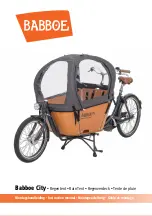
You will find separate instructions for the
components in the box of accessories supplied
with the bike, or on the websites for the relevant
manufacturers. If you have any questions about
assembly, adjustments, maintenance and use,
contact your approved O2Feel reseller.
Cyclists may get injured if the transmission
components are loose, worn, damaged or not
adjusted properly. Always get your rear derailleur
serviced by your approved O2Feel reseller.
Always contact your approved O2Feel reseller
if:
•
Your chain jumps, or
•
You hear an unusual noise, or
•
The gears do not change seamlessly, or
•
The gear changing mechanism, the derailleur or
any other component of the drivetrain system is
not tightened properly, damaged or twisted, or
•
The chain is faulty or worn.
2.5.3 Wheels
Checking the wheels
The wheels are the point of contact between the
bike and the ground. Ground surface irregularities
and the weight of the cyclist put a significant strain
on wheels.
The wheels are carefully checked and aligned
before delivery. However, the spokes will align
themselves over the first few miles that you cycle.
Get your wheels checked by your approved
O2Feel reseller after travelling 100 kilometres and,
if necessary, get them realigned. After that, make
sure they are checked regularly when carrying out
maintenance on your bike.
The wheel can be attached to the frame and the
fork in different ways. As well as the common
systems with which the wheel is attached thanks
to axle nuts or quick releases, there are different
kinds of wheel axles. They can be screwed on or
attached using different kinds of quick releases.
Checking the hub
Follow these steps to check the hub:
Lift the wheel and spin it around.
When you do this, make sure the wheel continues
to turn for a few spins, then stops. If it stops
suddenly, a bearing is damaged.
To check to see if the hub is loose, try to move the
wheel sideways (both ways) in the fork or in the
rear structure.
If there is some movement between the bearings,
or if the wheel does not turn easily, ask a specialist
reseller to adjust the hub.
Checking the rims
Rims will experience more wear if you are using a
rim brake.
A worn rim loses stability and is therefore more
likely to get damaged. A misshapen, cracked or
broken rim can cause serious accidents. Stop
riding the bike if you notice any changes to the
rim. Ask your approved O2Feel reseller to check
the damaged rim.
The rims on bikes bigger than 24” are equipped
with a wear indicator. A characteristic line can be
found on the side of the rim, or there will be a
groove all around the rim.
Replace the rim as soon as you notice any marks
(grooves, coloured areas) anywhere on the rim, or
if an engraved marking disappears or any coloured
writing becomes worn.
If the wear indicator is a groove or several points
on the side of the rim, replace the rim as soon as
these marks disappear.
Tyres
There are lots of different kinds of tyres. Their
properties and their rolling resistance depends on
their profile.
Do not exceed the stipulated inflation pressure for
the tyre. If you do, the tyre could burst.
Pump air into the tyre to achieve at least the
recommended minimum inflation pressure. If the
pressure is too low, the tyre could come away
from the rim.
The maximum and minimum inflation pressures
are usually indicated on the side of the tyre.
When changing tyres, only use the same kind
of tyre, with the same dimensions and the same
profile. Using different tyres may have a negative
effect on the handling characteristics of your bike.
This will potentially result in an accident.
36
















































